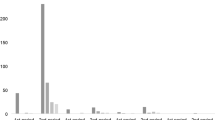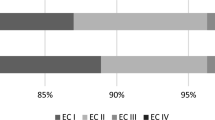Abstract
Epilepsy surgery has been shown to be an effective treatment for patients with intractable epilepsy. The only randomized controlled trial conducted in this setting to date found a dramatic advantage for surgery over medical treatment in temporal lobe epilepsy. In carefully selected patients, epilepsy surgery can control seizures, improve quality of life and reduce costs of medical care. Advances in diagnostic techniques are likely to improve patient selection, facilitate localization of epileptic foci and functional areas, and enable better prediction of outcomes.
Key Points
-
Epilepsy surgery has an important role in the management of chronic epilepsy
-
Currently, intractable epilepsy is defined by failure to achieve seizure cessation and intolerance of treatment
-
Major criteria for intractable epilepsy are the failure of seizure control with three anticonvulsant drugs and the presence of hippocampal sclerosis or cortical dysgenesis
-
A randomized trial of temporal lobe surgery versus medical management showed a 58% seizure-free outcome rate for the surgical group, compared with 8% for the medical management group
-
New surgical strategies include electrical cortical stimulation on demand and continuous deep brain thalamic and temporal lobe stimulation
This is a preview of subscription content, access via your institution
Access options
Subscribe to this journal
Receive 12 print issues and online access
$209.00 per year
only $17.42 per issue
Buy this article
- Purchase on Springer Link
- Instant access to full article PDF
Prices may be subject to local taxes which are calculated during checkout



Similar content being viewed by others
References
Hauser WA and Kurland LT (1975) The epidemiology of epilepsy in Rochester, Minnesota, 1935 through 1967. Epilepsia 16: 1–66
Kwan P and Brodie MJ (2000) Early identification of refractory epilepsy. N Engl J Med 342: 314–319
Silfvenius H (1999) Cost–benefit of epilepsy surgery. Acta Neurol Belg 99: 266–274
Cascino GD (1990) Intractable partial epilepsy: evaluation and treatment. Mayo Clin Proc 65: 1578–1586
Spencer S et al. (2005) Predicting long-term seizure outcome after resective epilepsy surgery. Neurology 65: 912–918
Vickrey BG et al. (1995) Outcome assessment for epilepsy surgery: the impact of measuring health-related quality of life. Ann Neurol 37: 158–166
Semah F et al. (1998) Is the underlying cause of epilepsy a major prognostic factor for recurrence? Neurology 51: 1256–1262
Armon C et al. (1996) Predictors of outcome of epilepsy surgery: multivariate analysis with validation. Epilepsia 37: 814–821
Holmes MD et al. (2000) Outcome after surgery in patients with refractory temporal lobe epilepsy and normal MRI. Seizure 9: 407–411
Dlugos DJ (2001) The early identification of candidates for epilepsy surgery. Arch Neurol 58: 1543–1546
Hennessy MJ et al. (2001) Predictors of outcome and pathological considerations in the surgical treatment of intractable epilepsy associated with temporal lobe lesions. J Neurol Neurosurg Psychiatry 70: 450–458
Engel JJ (1993) Surgical Treatment of the Epilepsies, edn 2. New York: Raven Press
Andermann F (1997) Brain structure and epilepsy: the impact of modern imaging. AJNR Am J Neuroradiol 18: 302–306
Luders HO (1992) Epilepsy Surgery. New York: Raven Press
Janszky J et al. (2001) Surgically treatable epilepsy—a review [Hungarian]. Orv Hetil 142: 1597–1604
Spencer SS et al. (1990) Combined depth and subdural electrode investigation in uncontrolled epilepsy. Neurology 40: 74–79
Kuzniecky RI and Knowlton RC (2002) Neuroimaging of epilepsy. Semin Neurol 22: 279–288
Cascino GD (1995) Clinical correlations with hippocampal atrophy. Magn Reson Imaging 13: 1133–1136
Rodríguez-Barrionuevo AC (1996) Neurocutaneous syndromes with predominant vascular anomalies [Spanish]. Rev Neurol 24: 1072–1084
David J et al. (1991) Scleroderma 'en coup de sabre'. Ann Rheum Dis 50: 260–262
Prayson RA et al. (1999) Linear epidermal nevus and nevus sebaceus syndromes: a clinicopathologic study of 3 patients. Arch Pathol Lab Med 123: 301–305
Campistol J (2002) Congenital errors of metabolism with epileptic seizures during the first years of life [Spanish]. Rev Neurol 35 (Suppl 1): S3–S20
Oguni H (2005) Symptomatic epilepsies imitating idiopathic generalized epilepsies. Epilepsia 46 (Suppl 9): S84–S90
Roquer J et al. (1994) Axillary skin biopsy: a reliable diagnostic test for Lafora's disease [Spanish]. Neurologia 9: 431–432
Gates JR et al. (1985) Ictal characteristics of pseudoseizures. Arch Neurol 42: 1183–1187
Ebersole JS and Pacia SV (1996) Localization of temporal lobe foci by ictal EEG patterns. Epilepsia 37: 386–399
Spencer SS (1989) Controversies in epileptology: depth vs subdural electrode studies for unlocalized epilepsy. J Epilepsy 2: 123–127
Juhasz C et al. (2001) Neuroradiological assessment of brain structure and function and its implication in the pathogenesis of West syndrome. Brain Dev 23: 488–495
Kuzniecky R et al. (1987) Magnetic resonance imaging in temporal lobe epilepsy: pathological correlations. Ann Neurol 22: 341–347
Berkovic SF et al. (1995) Preoperative MRI predicts outcome of temporal lobectomy: an actuarial analysis. Neurology 45: 1358–1363
Cascino GD et al. (1992) Magnetic resonance imaging in intractable frontal lobe epilepsy: pathologic correlation and prognostic importance. Epilepsy Res 11: 51–59
Wieshmann U (2003) Clinical application of neuroimaging in epilepsy. J Neurol Neurosurg Psychiatry 74: 466–470
Chugani DC and Chugani HT (2000) New directions in PET neuroimaging for neocortical epilepsy. Adv Neurol 84: 447–456
Knowlton RC et al. (1997) Presurgical multimodality neuroimaging in electroencephalographic lateralized temporal lobe epilepsy. Ann Neurol 42: 829–837
Kuzniecky R (1988) Focal cortical dysplasia. J Neurosurg 69: 478
Kuzniecky R et al. (2001) Magnetic resonance spectroscopic imaging in temporal lobe epilepsy: neuronal dysfunction or cell loss? Arch Neurol 58: 2048–2053
Gaillard WD et al. (2001) Cortical localization of reading in normal children: an fMRI language study. Neurology 57: 47–54
Richardson MP (2002) Functional imaging in epilepsy. Seizure 11 (Suppl A): S139–S156
Matthews PM et al. (2003) Towards understanding language organisation in the brain using fMRI. Hum Brain Mapp 18: 239–247
Sabbah P et al. (2003) Functional MR imaging in assessment of language dominance in epileptic patients. Neuroimage 18: 460–467
O'Brien TJ et al. (1998) Subtraction ictal SPECT co-registered to MRI improves clinical usefulness of SPECT in localizing the surgical seizure focus. Neurology 50: 445–454
Sutherling WW et al. (2001) Dipole localization of human induced focal afterdischarge seizure in simultaneous magnetoencephalography and electrocorticography. Brain Topogr 14: 101–116
Iida K et al. (2005) Characterizing magnetic spike sources by using magnetoencephalography-guided neuronavigation in epilepsy surgery in pediatric patients. J Neurosurg 102 (2 Suppl): S187–S196
Knowlton RC et al. (2006) Magnetic source imaging versus intracranial electroencephalogram in epilepsy surgery: a prospective study. Ann Neurol 59: 835–842
Alpherts WC et al. (2000) The wada test: prediction of focus lateralization by asymmetric and symmetric recall. Epilepsy Res 39: 239–249
Williamson PD et al. (1985) Complex partial seizures of frontal lobe origin. Ann Neurol 18: 497–504
Penfield W and Jasper H (1954) Epilepsy and the Functional Anatomy of the Human Brain. Boston: Little Brown and Company
French JA et al. (1993) Characteristics of medial temporal lobe epilepsy: I. Results of history and physical examination. Ann Neurol 34: 774–780
Benifla M et al. (2006) Temporal lobe surgery for intractable epilepsy in children: an analysis of outcomes in 126 children. Neurosurgery 59: 1203–1213
Boon P et al. (1994) Clinical and neurophysiological correlations in patients with refractory partial epilepsy and intracranial structural lesions. Acta Neurochir (Wien) 128: 68–83
Cappabianca P et al. (1997) Supratentorial cavernous malformations and epilepsy: seizure outcome after lesionectomy on a series of 35 patients. Clin Neurol Neurosurg 99: 179–183
Pacia SV et al. (1996) Clinical features of neocortical temporal lobe epilepsy. Ann Neurol 40: 724–730
Luders H (1996) Supplementary sensorimotor area. In Advances in Neurology, vol. 70, 495–499 (Ed. Luders H) Philadelphia: Lippincott-Raven
Roberts DW et al. (2001) Investigation of extra-temporal epilepsy. Stereotact Funct Neurosurg 77: 216–218
Devlin AM et al. (2003) Clinical outcomes of hemispherectomy for epilepsy in childhood and adolescence. Brain 126: 556–566
van Empelen R et al. (2004) Functional consequences of hemispherectomy. Brain 127: 2071–2079.
Reutens DC et al. (1993) Corpus callosotomy for intractable epilepsy: seizure outcome and prognostic factors. Epilepsia 34: 904–909
Sorenson JM et al. (1997) Corpus callosotomy for medically intractable seizures. Pediatr Neurosurg 27: 260–267
Kuzniecky R et al. (1997) Intrinsic epileptogenesis of hypothalamic hamartomas in gelastic epilepsy. Ann Neurol 42: 60–67
Valdueza J et al. (1994) Hypothalamic hamartomas: with special reference to gelastic epilepsy and surgery. Neurosurgery 34: 949–958
Regis J et al. (2000) Gamma knife surgery for epilepsy related to hypothalamic hamartomas. Neurosurgery 47: 1343–1351
Mulligan LP et al. (2001) Multiple subpial transections: the Yale experience. Epilepsia 42: 226–229
Tecoma ES and Iragui VJ (2006) Vagus nerve stimulation use and effect in epilepsy: what have we learned? Epilepsy Behav 8: 127–136
Lesser RP et al. (1999) Brief bursts of pulse stimulation terminate afterdischarges caused by cortical stimulation. Neurology 53: 2073–2081
Boon P et al. (2007) Deep brain stimulation in patients with refractory temporal lobe epilepsy. Epilepsia 48: 1551–1560
Velasco AL et al. (2006) Neuromodulation of the centromedian thalamic nuclei in the treatment of generalized seizures and the improvement of the quality of life in patients with Lennox–Gastaut syndrome. Epilepsia 47: 1203–1212
Wiebe S et al. (2001) Effectiveness and efficiency of surgery for temporal lobe epilepsy study group. N Engl J Med 345: 311–318
Guldvog B et al. (1994) Surgical treatment of partial epilepsy among Norwegian adults. Epilepsia 35: 540–553
Téllez-Zenteno J et al. (2007) Long-term outcomes in epilepsy surgery: AED, mortality, cognitive and psychosocial aspects. Brain 130: 334–345
Devinsky O and Penry JK (1993) Quality of life in epilepsy: the clinician's view. Epilepsia 34 (Suppl 4): S4–S7
Vickrey BG et al. (1993) Outcomes with respect to quality of life. In Surgical Treatment of the Epilepsies, edn 2 623–635 (Ed. Engel J) New York: Raven Press
Locharernkul C et al. (2005) Quality of life after successful epilepsy surgery: evaluation by occupational achievement and income acquisition. J Med Assoc Thai 88 (Suppl 4): S207–S213
Alpherts WC et al. (2006) Verbal memory decline after temporal epilepsy surgery? A 6-year multiple assessments follow-up study. Neurology 22: 626–631
Monté CP et al. (2006) Sudden unexpected death in epilepsy patients: risk factors: a systematic review. Seizure 16: 1–7
Sperling MR et al. (1999) Seizure control and mortality in epilepsy. Ann Neurol 46: 45–50
Acknowledgements
The authors' work is partially supported by the FACES Foundation (Finding A Cure for Epilepsy and Seizures). Charles P Vega, University of California, Irvine, CA, is the author of and is solely responsible for the content of the learning objectives, questions and answers of the Medscape-accredited continuing medical education activity associated with this article.
Author information
Authors and Affiliations
Corresponding author
Ethics declarations
Competing interests
The authors declare no competing financial interests.
Rights and permissions
About this article
Cite this article
Kuzniecky, R., Devinsky, O. Surgery Insight: surgical management of epilepsy. Nat Rev Neurol 3, 673–681 (2007). https://doi.org/10.1038/ncpneuro0663
Received:
Accepted:
Issue Date:
DOI: https://doi.org/10.1038/ncpneuro0663



